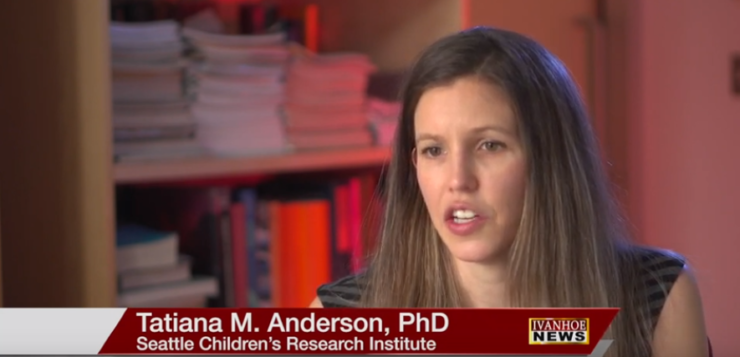Tatiana M. Anderson, PhD, Neuroscientist at Seattle Children’s Research Institute talks about SIDS and how doctors partnering with data analysts is providing answers.
Interview conducted by Ivanhoe Broadcast News in April 2019.
How’d you get the information for the paper?
ANDERSON: We get the data through the CDC and they have a publicly available database where they post data for every single birth in the United States and then link that to death certificates. We analyzed over 20 million births in the United States which included over 19000 cases of sudden and unexpected infant death. We partnered with Microsoft and professional data scientists who are able to routinely analyze millions of pieces of data. What makes this partnership amazing is that, as scientists, we’re familiar with literature search, gaps of knowledge, and disseminating data in medical journals and that gets paired with the data science skills. Hopefully this is the first of many papers to stem from this partnership.
Tell us a little about what you found.
ANDERSON: We were looking at the relationship between smoking during pregnancy and increased risk of sudden unexpected death. That relationship has been described in the past, however, what is really new about this paper is the fact that we have much higher resolution on that relationship due to a large dataset. We found that just smoking a single cigarette a day during pregnancy doubles your risk of Sudden Unexpected Infant Death. From one to 20 cigarettes, that risk is linear. It increases with every single cigarette that you smoke. That granularity is something that we weren’t able to see in the data before. We also found that 8.9 percent of mothers smoke during pregnancy and 55 percent of those don’t quit or reduce their smoking consumption during pregnancy. And so one of the biggest take home messages is that we want doctors to have these real conversations with their patients explain the increased risk even if you’re only smoking a single cigarette a day. And for those that refuse or are unable to quit, every cigarette that is reduced can make a difference.
Can you reduce your risk if you’re smoking for the first trimester and then stop?
ANDERSON: So interestingly, we also looked at smoking before pregnancy. Those who smoked in the three months before becoming pregnant and quit by the first trimester still had about a 50 percent increased risk of SUID. That’s another conversation that the doctor should absolutely be having with their patients. If you’re planning on becoming pregnant, quit well before you actually get pregnant.
If you stopped cold turkey, you’re still going to have the 50 percent risk?
ANDERSON: You still have a risk but your risk is going to be lower than not quitting at all.
OK. But if it’s 50 percent you’re smoking right before then it sounds like it’s not going to be a negligible decrease right?
ANDERSON: You’re going from baseline risk to 50 percent increased risk. But if you are smoking during pregnancy and you have just one cigarette a day you’re at 200 percent risk from baseline. So it’s a big difference.
Let’s talk about incidents of deaths of babies.
ANDERSON: Sure. We estimate using our model that approximately eight hundred infant deaths in the United States could be prevented each year if no women smoked during pregnancy.
That’s unbelievable. We talked to John Kahan and it looked like he had no risk factors. It seems it’s still a mystery even after all these years.
ANDERSON: Yes, it is. It’s a diagnosis of exclusion. We can’t find any other reason to explain this child’s death. Because of that it’s probably a heterogeneous population. There are probably multiple causes that are kind of thrown in under this umbrella term of SIDS or SUID and so that’s one of the reasons why we’re trying to build this genome database. We are collecting samples from cases of SIDS or SUID and performing whole genome sequencing so that we can use these big data analysis tools to look for novel gene candidates. We’d ultimately like to start figuring out some subpopulations within the entire population that can be explained, for example a cardiac channelopathy or some other cause that wasn’t detected at autopsy, but could at least give parents a potential answer for their child’s death.
A little bit of closure. What’s next with the partnership and the big data plus big science?
ANDERSON: Well, we hope that this is just the first of many manuscripts- we’ve got a couple more in the pipeline that we’re excited about.
Is there anything that you wanted to make sure that we include in the story?
ANDERSON: Well it’s been an extraordinarily amazing partnership and I’ve really enjoyed getting to work with these talented data scientists. I think that it is a recipe that can be duplicated for answering many questions, not just health related, but perhaps questions related to climate change or the opioid epidemic. By meshing the science/academia world with industry/data science, I think we can make some really big and positive changes.
END OF INTERVIEW
This information is intended for additional research purposes only. It is not to be used as a prescription or advice from Ivanhoe Broadcast News, Inc. or any medical professional interviewed. Ivanhoe Broadcast News, Inc. assumes no responsibility for the depth or accuracy of physician statements. Procedures or medicines apply to different people and medical factors; always consult your physician on medical matters.
If you would like more information, please contact:
Lindsay Kurs
206-987-5752
lindsay.Kurs@seattlechildrens.org
Sign up for a free weekly e-mail on Medical Breakthroughs called First to Know by clicking here




